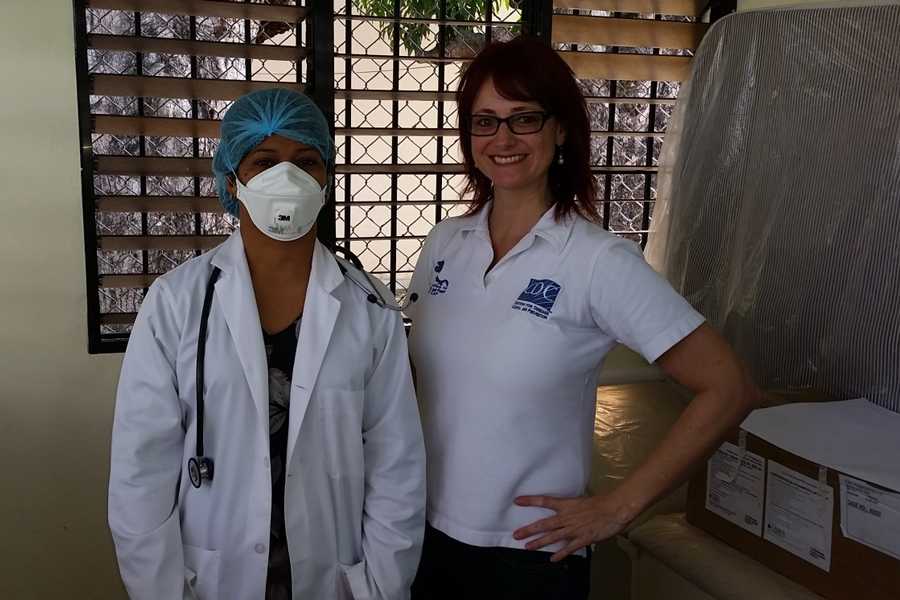Scaling-Up TB Infection Control Practices in the Central America Region: A Profile of Dr. Diana Forno

Dr. Diana Forno, CDC-Central America Regional (CAR) Office Tuberculosis/HIV Epidemiologist (right) with a TB clinic physician demonstrating the use of personal protective equipment during a TB infection-control training and facility risk assessment in the Dominican Republic. Photo source: CDC-CAR
Dr. Diana Forno is a physician and licensed surgeon in Guatemala and has extensive experience working in several national and international health agencies, including in the United States. She began working with the CDC-Central America Regional Office (CDC-CAR) in 2012 as a Tuberculosis (TB)/HIV Epidemiologist and Activity Manager. Dr. Forno notes that what she most enjoys about working at CDC is “the opportunity to bring the best technical support to the countries that most need it to help control and prevent high burden diseases such as TB and HIV.”
Identifying regional needs
Through the U.S. President’s Emergency Plan for AIDS Relief (PEPFAR) CDC-CAR helps Ministries of Health (MOH) in seven countries implement HIV and TB prevention, care, and treatment programs and services: Belize, Costa Rica, El Salvador, Guatemala, Honduras, Nicaragua, and Panama. Rates of TB are higher in HIV-infected persons and they are more vulnerable to developing TB disease if exposed, so implementing TB infection control activities is especially important for improving health outcomes in these patients.
Training TB infection control champions
As part of her leadership role in the region, Dr. Forno works with MOHs and partners to conduct TB infection control (TBIC) trainings and evaluations at healthcare facilities to reduce the risk of TB transmission to patients and healthcare workers. She has supported TBIC activities at both national and facility levels by assisting MOHs in developing national guidelines and by working with facilities to develop their facility-specific plans. Using the TBIC materials developed by CDC Division of Global HIV/AIDS in collaboration with implementing partners, she has conducted trainings for healthcare workers in Belize, Guatemala, Honduras, Nicaragua and Panama. In addition, she also has conducted a training in the Dominican Republic as part of a collaboration with CDC-Dominican Republic. All the trainings have been targeted to nurses, doctors, and laboratory technicians and include hands-on training in conducting a facility risk assessment and in monitoring TBIC practices.

Dr. Forno at a TB infection control training in Belize City with staff from healthcare facilities, the Ministry of Health, and implementing partners. Photo source: CDC-CAR
Supporting sustainability
Regular monitoring to ensure the quality of TBIC practices is being led by facility staff, and external follow-up assessments will be conducted by CDC and partner MOHs in the summer of 2015. Some sites are already showing improvement; for example, one site in Guatemala established an infection control committee, moved a congested indoor waiting area to a covered area outside, and created an electronic system that helps collect data from HIV-positive TB patients to improve the co-management of both diseases and ensure that persons diagnosed with TB start TB treatment as soon as possible.
Dr. Forno anticipates that there will be additional training of trainers in the five countries to roll out TBIC in other high burden TB and HIV districts and to ensure sustainability and ownership of the activities. “Moving forward, the goal is to have a local champion who will monitor implementation of TBIC plans in all sites and follow-up on recommendations.”
- Page last reviewed: March 17, 2015
- Page last updated: March 17, 2015
- Content source:
Global Health
Notice: Linking to a non-federal site does not constitute an endorsement by HHS, CDC or any of its employees of the sponsors or the information and products presented on the site.


 ShareCompartir
ShareCompartir